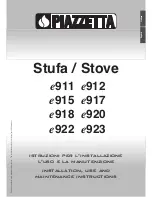
OPERATION
Do not use a grate or elevate the fire
. Build the wood.
When the stove is used for the first time, solvents in
the paint will smoke off as the stove “cures.”
WOOD
This heater is designed to burn natural wood only.
Higher efficiency and lower emissions generally
result when burning air-dried seasoned hardwood,
as compared to softwood or to green or freshly-cut
hardwood.
Use only dry, seasoned wood. Green wood, besides
burning at only 60 percent of the fuel value of dry
wood, deposits creosote on the inside of the stove and
along the chimney. This can cause extreme danger of
chimney fire.
To be called “seasoned,” wood must be
dried for a year
. Regardless of whether the wood is
green or seasoned, it should be stored in a ventilated,
sheltered area to allow proper drying during the
year. Wood should be stored beyond recommended
clearances from combustibles.
DO NOT BURN:
Treated Wood, Garbage, Solvents, Trash, Cardboard,
Colored Paper or Coal.
FIRST FIRE
• Fit the baffle as shown in the section “Fitting the
Baffle”
• Allow the stove to cure before burning for long
periods of time at high temperatures.
• When the fireplace is lit for the first time, the fireplace
will produce smoke and smell
like resin for a few hours. Open the windows to
ventilate.
• Flat spots on the painted surface are normal.
• Shiny spots on the painted surface (before burning)
are normal.
• Call Technical Support at (800) - 444 - 6742 if you
have any questions.
BUILDING A FIRE
1.
Open the air inlet control fully.
2.
Place a small amount of crumpled paper in the
stove.
3.
Cover the paper with a generous amount of
kindling in a “teepee” shape, and a few small pieces
of wood.
4.
Ignite this fuel and close the door most of the way
(leave it open slightly).
5.
Add larger pieces of wood as the fire progresses,
being careful not to overload.
Do not fill the firebox
beyond the firebrick area, as this may result in
over-firing
. A coal bed of (ideally) 1” to 2” should be
established to achieve optimum performance.
6.
This unit is designed to function most effectively
when air is allowed to circulate to all areas of the
firebox. A good way of achieving this is to rake a small
(1” to 2” wide) “trough” in the center of the coal bed,
from front to back, prior to loading the fuel.
7.
Once fuel has been loaded, close the door and
fully open the air inlet control, until the fire is well
established (approximately 20 minutes), being careful
not to over-fire.
8.
Readjust the air inlet control to the desired burn
rate. If excessive smoke fills the firebox, open the
air inlet control slightly, until flames resume and the
wood is sufficiently ignited. Basically, Closed = “Low;”
½ Way Open = “Medium;” and Fully Open = “High.”
9.
When refueling, adjust the air control to
the fully open position
. When the fire brightens,
open the door
VERY
slowly and carefully. This will
prevent gases from igniting and causing smoke and
flame spillage.
10.
At this point you may add fuel, being careful not
to overload.
The use of flammable liquids, too much wood or
burning trash in the stove may result in an “over¬fired”
unit. If the chimney connector pipe or stove turns red
or white, the stove has been over-fired. In the event
this happens, close the air control immediately! This
condition can ignite creosote in the chimney and
cause a house or chimney fire. This type fire can cause
structural damage to the chimney system; do not
use the stove again until the entire system has been
checked thoroughly and any damaged parts repaired
or replaced. A chimney sweep can normally perform
this inspection.
NEVER USE GASOLINE, GASOLINE-TYPE LANTERN
FUEL, KEROSENE, CHARCOAL LIGHTER FLUID, OR
SIMILAR LIQUIDS TO
START OR ‘FRESHEN
UP’ A FIRE IN THIS
HEATER. KEEP ALL
SUCH LIQUIDS WELL
AWAY FROM THE
HEATER WHILE IT IS
IN USE.
GLASS CARE
REPLACE GLASS ONLY WITH CERAMIC GLASS
USE HIGH-TEMPERATURE ROBAX® PYROCERAM or
NEOCERAM® OF THE PROPER SIZE AND THICKNESS.
N 380 glass thickness : 5 mm / 0.19 in
N 380 glass size
: 280 mm x 280 mm
: 11.02 in x 11.02 in
The following use and safety tips should be
observed:
1.
Inspect the glass regularly for cracks or breaks.
Surface scratches are acceptable and normal, but
if you detect a crack or a break, extinguish the fire
immediately, and contact your dealer or Technical
Support at 800-444-6742 for replacement.
2.
Do not slam the door or otherwise impact the
glass. When closing doors, make sure that logs or
other objects do not protrude and impact the glass.
3.
Do not clean the glass with materials which may
scratch (or otherwise damage) the glass. Scratches on
the glass can develop into cracks or breaks.
4.
Never attempt to clean the glass while the unit
is hot. If the deposit is not very heavy, normal glass
cleaners are adequate with a plain, non-abrasive
scouring pad. Heavier deposits may be removed with
the use of an oven cleaner.
12
13
Содержание N 380
Страница 22: ......








































